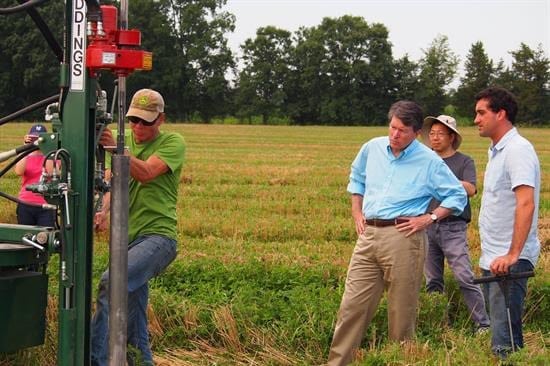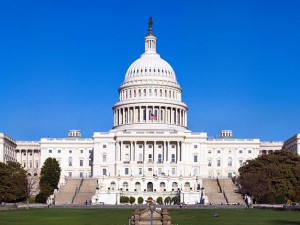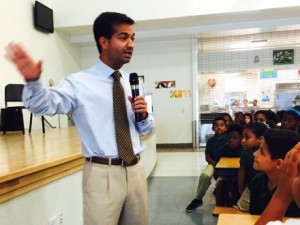
Congressman John Faso (R-NY) at Stone House Farm in Hudson, NY, with farm manager Ben Dobson, observing retrieval of a soil core.
By Mary Gable
The path to passing a nationwide Carbon Fee and Dividend requires building connections, sharing knowledge, and celebrating small wins along the way. Most of all, it requires listening. The recent achievements of our Columbia County, N.Y. chapter are a prime example of this strategy at work.
Small-scale farmers abound in rural Columbia County. In January, the area’s CCL chapter hosted an event to educate community members on the potential of carbon farming practices to offset the effects of climate change, bringing together scientists, growers and experts in land management. The gathering also caught the attention of political leaders, including U.S. Representative John Faso, who represents New York’s 19th Congressional District and sits on the House Agriculture Committee. He’s also a member of the bipartisan House Climate Solutions Caucus.
As a follow-up to this event, CCL representatives invited Rep. Faso to visit a farm in his district to learn more about carbon farming and hear from his constituents. Faso said yes, and the Congressman, along with the CCL chapter’s Agriculture Liaison Jan Storm, paid a visit to the nearby Stone House Farm.
Stone House Farm is a living model of the many benefits of regenerative agriculture. The farm’s key practices—including tillage reduction, cover crops, companion planting, crop rotation, planned grazing and keyline plowing—improve soil quality, making it more resilient to climate conditions like flooding and drought and less susceptible to erosion. These practices also increase soil’s organic matter. Soils with more organic matter require less fertilizer, which in turn means less runoff into waterways and greater profitability for farmers. Perhaps most important of all, managing farms this way actually draws carbon out of the atmosphere. If all cropland in the U.S. was farmed using regenerative practices, the GHG reduction would be equivalent to eliminating nearly 90 percent of our country’s cars.
Generating support for regenerative farming
Rep. Faso was impressed by Stone House Farm’s success. Now, he’s hoping to share what he’s learned with others in Congress. He has called for incentives for carbon sequestration farming programs and asked for CCL’s help in identifying farms across the country practicing regenerative agriculture, particularly those in districts with a representative on the House Agriculture Committee.
That’s a big win—and it’s not the only way that support for sustainable agriculture is growing in upstate New York. In February, State Assemblywoman Didi Barrett introduced legislation to offer tax credits for carbon farming. While other states have established programs to help farmers respond to climate change, Barrett’s proposed credit would be the first to give tax breaks to farmers who use regenerative, climate-mitigating techniques.
Jan Storm attended Barrett’s press conference announcing the bill. Storm, via CCL, is also encouraging the Columbia County Farm Bureau to support or incentivize carbon farming, and to urge the New York State and national Farm Bureaus to do the same. She is also helping spread awareness of the benefits of carbon-sequestering farming practices to more of our members by helping organize a webinar series (see details below).
The power of listening
How is this creating political will in favor of a Carbon Fee & Dividend? First, it’s gotten elected officials talking with their constituents about climate solutions. It has also given local farmers a platform to share their ideas. The Columbia County chapter and other New York state CCL chapters will continue to meet with farmers in the Hudson Valley and throughout rural upstate New York to explore how CCL’s advocacy for a revenue-neutral carbon price can complement advocacy for agriculture practices that sequester carbon.
Finally, CCL’s support for farmers has earned their trust, which has helped move the needle on backing for carbon pricing. “In some cases, that simply means that a farmer has gone from opposing a carbon fee to saying, ‘It depends,’” says Storm.
“It’s a small thing, but that shift matters. This work takes time. And it starts when we listen.”
Starting Monday, October 2, tune in to “Agriculture at the Table: Land Use Practices that Extract and Store Carbon,” a six-part webinar series organized by the CCL Agriculture Action Team. Learn how farmers, ranchers and foresters mitigate climate risk by sequestering carbon, what policies they need to scale up their practices, and how we can help. Six webinars will be held on six sequential Mondays at 8 p.m. Eastern time. Learn more here.




